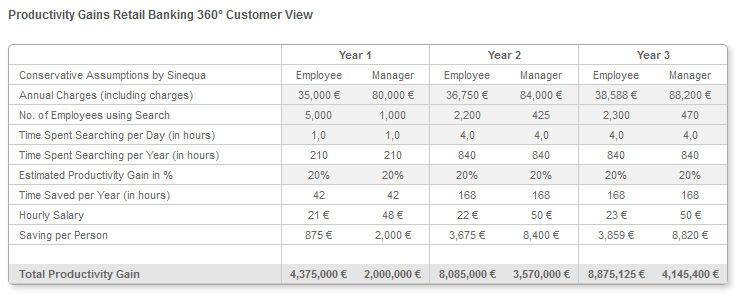ROI Categories in Unified Information Access Projects

The Unified Information Access (UIA) market is a logical evolution of what used to be called the Enterprise Search market. Organisations use search technology in in new and innovative ways to access data of all kinds and present employees, customers and partners with relevant information. Return on investment varies greatly with each new use case, attaining previously unimagined levels.
UIA projects must not just unify and simplify access to data for users and for IT departments, it must deliver relevant information to users, structure it and create adequate information categories.
Looking at customer projects, we can distinguish three different categories of ROI, corresponding to different use cases:
- “Sand Dune” ROI: Many people (thousands to tens of thousands) save small amounts of time in lots of searches, adding up to impressive amounts of time saved in the course of a year.
- “Rock” or “Nugget” ROI: A single fruitful searches can save tens of thousands and even hundreds of thousands of Euros.
- “Beyond ROI: Can’t work anymore without it”: Unified Information Access improves one or more core business processes such that it becomes indispensable to maintain competitiveness.
Of course there are more categories, for example IT landscape optimization, but we will illustrate diversity with these categories.
In all cases, UIA projects tend to move closer to the heart of organisations’ business and towards the centre of their IT systems. This increased business relevance makes it easier to define ROI metrics and to measure them. Nevertheless, calculations using the data provided by customers and metrics they agree upon result quite often in ROI figures they find utterly surprising! They usually underestimate the overall time spent looking for information and overestimate the cost of UIA projects.
“Sand Dune” ROI
Consider the case of one of the largest European retail banks, as a point in case for the accumulation of many small gains (“sand grains”) to a very large ROI (“sand dune”). In fact, the time saved by several tens of thousands of employees across about 40 regional organisations adds up to staggering amounts.
If one could add in the time saved by several millions of customers accessing the customer portal of the bank on the Internet, the results would be astronomical. But of course, one cannot multiply working hours of customers by an average personnel cost and add them into the ROI calculations.
The benefits provided to customers in terms of more rapid and more relevant answers to their questions may be factored into ROI calculations by considering customer satisfaction indices or reduced churn rates. Gains from reduced churn rates, for example at mobile phone operators, are usually astronomical as well.
Coming back to the “sand grains” and the concrete case of our European retail bank:
ROI calculations have been made using tables originally suggested by Gartner and other analysts, using time savings estimated by the Bank.

Of course, these calculations use a customer’s projective figures, not minutes and seconds actually measured.
“Rock” or “Nugget” ROI
One of our large industrial customers has several search projects going within the group. One of them is concerned with “Technology Search”. Consider a large project aimed at building a new piece of technology. Within a company of more than 350 000 employees distributed over many countries, the chances are that many components of the new technology have already been developed in one of its units.
Take the example of for 3-D rendering component needed in a new project. Information on internally available technologies could be spread across different divisions ranging from Patents via Medical Equipment to Energy Products.
Finding the right technology (or the right expert who can advise on the relevant technology) can save tens of thousands to hundreds of thousands of Euros by avoiding redundant R&D investments – not to speak of the benefits of a shorter time to market.
Beyond ROI: Can’t work anymore without it
Searching for experts is at the heart of the business of consulting and service companies: Finding the right experts when staffing a project – in particular a fixed-price project – may well tip the balance between winning or losing money, and of course between customer satisfaction and dissatisfaction.
One of the largest IT consulting and services companies in Europe with close to 80.000 employees has implemented an application on top of the Sinequa UIA platform in order to find experts required for a given project. Expert search is not restricted to declarative data in enterprise social networks or HR data, but takes into account all kinds of documents like project reports, internal publications and even email. By including project planning data and agendas, one can also find the experts that are available at a given time.
The capacity of assembling the right teams of experts is not only critical when projects are about to start but much earlier: when responding to Requests for Proposal (RFP). Answering an RFP on short notice without being confident that the necessary expertise can be assembled when needed is very risky. Our customer had to renounce participating in RFPs in the past, because the company did not want to take such risks.
After implementing an expert search application on the Sinequa UIA platform, it is now able to compete more often and with confidence.
How does one calculate the ROI of such an expert search project? ROI = cumulated net margin of additional projects won?
The company does not do that. They argue that you risk going out of business if you can’t answer all relevant RFPs in your line of business. You simply “can’t do without it”.






